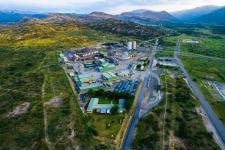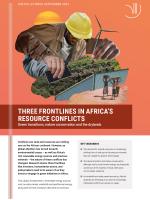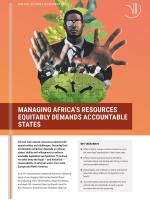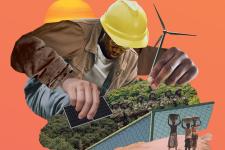Green exploitation is still exploitation

As the climate crisis worsens, much of the world is looking to Africa for the solution. As countries look to build a more sustainable future, the continent is seen as holding the key – and the resources – to power a green transition.
After all, Africa holds 90% of the world’s chromium, essential for solar and geothermal power, as well as 90% of its platinum, used in electric vehicles. The Democratic Republic of Congo alone is estimated to contain most of the world’s cobalt, demand for which is set to skyrocket due to its use in electronic goods. The same is true of manganese, the biggest two producers of which are South Africa and Gabon.
The list does not end there, nor with metals and minerals alone. Africa’s untouched forests and peatlands are also increasingly being romanticised as the solution to global biodiversity crises or to serve as vital carbon sinks. Policymakers from around the world last year, at the 2022 COP15 biodiversity summit, agreed to turn 30% of the world’s land into protected areas to preserve biodiversity. Meanwhile a Dubai-based company in recent months has secured rights over 24.5 million hectares – an area larger than the UK – in Kenya, Zimbabwe, Liberia, Tanzania and Zambia to produce carbon credits.
While the context of this turn to Africa is novel, this dynamic is not new. Under colonialism, imperial powers fought over Africa’s land and pillaged its natural resources to fuel industrialisation back home. Post-independence, Western states and companies have continued to mine and export the continent’s riches, this time justified by insidious notions of development and economic liberalisation. Both these eras of extraction have mainly driven the economic growth of foreign countries and corporations. People in Africa have largely stayed poor, been driven from their homes, and seen their environments destroyed.
Today, the goal for global powers looking to Africa’s resources and nature is a greener future, but the patterns are shaping up to be the same as ever. Almost 150 years after the first scramble for Africa, the narrative around “green transitions” and Africa’s role in it are mainly being shaped in European capitals and for Western interests.
Unless this changes, the result will remain a process through which Africa loses on multiple levels. Resources are extracted, often under dangerous working conditions and/or in ways that destroy the environment along with people’s livelihoods and property. The raw materials are then exported to be refined and used to produce goods – windmills, solar panels, and other technologies – in the likes of China, the US and Europe. The true value and benefits of the extracted minerals accrue in these latter countries, by and large leaving Africa out of the equation, a few elite beneficiaries notwithstanding.
Similar dynamics can be seen regarding Africa’s nature. As we mention above, in 2022, governments at COP15 biodiversity summit agreed on the 30x30 initiative, a target that 30% of the world’s land should be protected by 2030 to help mitigate climate change and address the biodiversity crisis. According to international policymakers and experts – often from the West – much of the world’s remaining untouched nature is in Africa.
What seems untouched at first glance, however, rarely is. Though it may not be used for industrial farming or resource extraction, much of this land is part of the commons that foragers, pastoralists, small-scale farmers, and households habitually use. These essential areas for grazing, farming, medicinal plants, wild-growing foods, fuelwood, and water are already increasingly scarce, not least due to warmer weather, rapid urbanisation, and growing populations.
Nonetheless, governments acting on behalf of transnational capital have exploited people’s lack of formal rights over land to dispossess them with force and impunity. States have superimposed their will on longstanding forms of ownership without consultation, compensation, or sensitivity to the livelihoods of dispossessed citizens. They have done so to facilitate the establishment of luxury wildlife parks or lucrative carbon offsetting schemes. For example in Kenya’s highlands in Laikipia, there has been ongoing violent conflict between pastoralists, small-scale farmers, and range owners—individuals controlling extensive land areas for grazing or farming. Many of these range owners have transformed their agricultural lands into protected nature reserves, thus entering the lucrative tourism industry and gaining the support of influential organizations dedicated to nature and environmental protection.
Again, the main beneficiaries of these are foreign corporations and a handful of elites.
The same power dynamics that affect Africa’s natural resources are now extended to peripheral drylands and frontier areas that were previously seen as undesirable. This growing interest has far-reaching consequences for marginalised social groups and inevitably generates local resistance and protests. These are, in turn, met by draconian responses from the state and agents of international corporations, thereby creating an intractable cycle of conflicts and repression.
The solution is political and African
Both during and since colonisation, Africa’s position in the world global value chain has been tied to exploitative relations with external actors. Today, rapacious political elites, many of whom arose during colonial exploitation, collude with outside business interests to support themselves and their extended families at the expense of functioning institutions and public services. An international community led by former colonising states benefit from and provide cover for this extraction.
This is true of how oil, gas, gold, diamonds, and many more resources are managed. And, as things stand, it is true of green resources from cobalt, manganese, lithium, and platinum to land for wildlife parks and carbon offsetting schemes.
Is it acceptable or sustainable that global efforts to combat climate change exclude and suppress certain communities in Africa? Our answer is that it is not.
However, these relationships of exploitation will not change unless political leaderships across Africa – military and civilian – are willing and able to change their ways of doing business. Only then will Africa, as a continent, be able to counter external pressures that history shows are unlikely to go away.
Africa needs leaders that are willing to make difficult, indeed revolutionary, decisions. This would transform forms of government that mostly benefit political elites into systems of distribution that are equitable and benefit populations more broadly. Similarly, it would mean that governments across the continent insist on holding external state and private sector actors accountable for the ways they do business.
The common denominator of these two changes is daring to have a long-term view on what Africa could and should look like in 20 or 30 years instead of pursuing quick wins.
DIIS Experts





